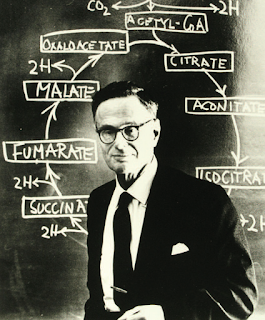 |
| Hans Krebs |
The way living things can maintain its function, do many activities, or just simply to survive in this harsh world sometimes can be mysterious. However, there is one way to understand these mysterious processes and science, especially chemical science, can help us to understand these processes. These processes are sometimes metabolic processes and it can be seen as chemical reactions that happen in living things, from bacteria to blue whale. One of the metabolic processes is called citric acid cycle (CAC) or famously named Krebs cycle; named after its discoverer Hans Krebs. Hans Krebs himself was awarded Nobel Prize in Physiology or Medicine in 1953.
This cycle is a series of chemical reactions to release stored-energy in form of adenosine triphosphate (ATP) and also provides the ingredients to synthesise amino acids and reducing agent NADH. In living cell, this cycle happens in the mitochondrion, the cell's power plant.
Since it is a cycle, unravelling this series of chemical reactions can be started from any points in the circle. However, for our convenience we can start from citrate ion, the ionised form of citric acid in biological conditions.
The citrate (6C) ions undergoes isomerisation process into isocitrate (6C) via aconitate with the helps of enzyme aconitase.
 |
| The enzyme mechanisms at aconitase active site for isomerisation of citrate to isocitrate |
In aconitase enzyme, two amino acid residues, His-101 and Ser-642, acts as acid and base catalysts. Citrate ion undergoes elimination to form aconitate ion and this process is facilitated by protonation of hydroxyl group by His-101 followed by deprotonation of acidic proton at ɑ-C by Ser-642. During this process, citrate, aconitate, and isocitrate is anchored to Fe4-S4 cluster. Then, changing of coordination of aconitate happens to ensure correct position to give isocitrate. The addition reaction between water molecule and aconitate ion happens via general acid-base catalysis. The attack on ɑ-C by water molecule give isocitrate ion. The whole process of transformation from citrate to isocitrate can be seen as isomerisation process and interestingly a single stereoisomer of isocitrate is generated from this process from non-chiral citrate ion.
Then, isocitrate (6C) undergoes oxidation and decarboxylation reactions ɑ-ketoglutarate (5C) and the transformation is catalysed by isocitrate dehydrogenase.
 |
| Enzyme mechanism of isocitrate transformation to ɑ-ketoglutarate |
The first step of this transformation is oxidation of isocitrate by NAD(P)
+ forming oxalosuccinate intermediate. The intermediate oxalosuccinate is hyphotetical due to never been observed in the decarboxylating version of the enzyme. In this mechanism, a unique feature in oxidation step where the hydroxyl and the neighbouring carboxylate groups are coordinated with Mn
2+. The oxidation process happens via deprotonation of acidic hydrogen on hydroxyl group by H-bonded water network and aspartate residue and the reduction of NAD(P)
+. Following the oxidation reaction, the decarboxylation process is facilitated by general acid-base catalysis of Tyr-140 as basic catalyst and Lys-2152 as acidic catalyst with the carbonyl and carboxylate are coordinated with Mg
2+ ion giving the enol form of ɑ-ketoglutaratte. Then, to produce the carbonyl-form of ɑ-ketoglutarate, tautomerisation happens and aided with general acid-base catalysis by the same residues; in this tautomerisation Tyr-140 acts as acid catalyst and Lys-2152 acts as basic catalyst. In this process, it generates NADPH and CO
2.
The formed ɑ-ketoglutarate (5C) is then transformed to succinyl-CoA (4C) and this transformation is catalysed by an enzyme complex of oxoglutarate dehydrogenase complex (OGDC) or ɑ-ketoglutarate dehydrogenase complex. This enzyme complex comprises of three components:
- oxoglutarate decarboxylase (OGDH) with cofactor thiamine pyrophosphate (TPP),
- dihidrolipoyl succinyltransferase (DLST) with cofactors lipoic acid and coenzyme A (CoA),
- dihidrolipoyl dehydrogenase (DLD) with cofactors FAD and NAD.
 |
| The enzyme mechanism of OGDC in transformation of ɑ-ketoglutarate to succinyl-CoA |
The transformation starts with deprotonation of TPP-H
+ forming TPP
which acts as nucleophile to the oxoglutarate and then forming tetrahedral intermediate. The tetrahedral intermediate then undergoes decarboxylation forming an enol-type structure which then react with lipoyl-R. The reaction with lipoyl-R happens via tetrahedral intermediate and after the intermediate collapse it forms succinyl-dihidrolipoyl thioester and TPP
- is regenerated. The intermediate thioester then undergoes trans-thioesterifacition with coenzyme forming the product succinyl-CoA and releasing dihidrolipoyl-R. which then oxidised by FAD to regenerate lipoyl-R and consequently FADH
2, the reduced formed of FAD, is also produced. Then, FADH
2 is oxidised by NAD
+ to regenerate FAD and forming NADH.
That's it for the first part of decoding Krebs cycle with starting from citrate with 6 carbons and halfway(-ish) of this cycle it is reduced to 4 carbons of succinyl-CoA releasing 2 molecules of CO
2. It is noteworthy that the metabolic pathway of Krebs cycle can be understood using reaction mechanisms in organic chemistry with the chemistry of carbonyls is the main feature in this case.
In the second part, the remaining of Krebs cycle will be decoded and we will see from succinyl-CoA to completing the cycle to citrate again. The highlight will be those reactions can be understood using mechanisms in organic chemistry.
References
- S. J. Lloyd, H. Lauble, G. S. Prasad, and C. D. Stout, Protein Sci., 1999, 8, 2655-2662.
- H. Kornberg, Nature Review Molecular Cell Biology, 2000, 1, 225-228.
- A.-E. Fedøy, N. Yang, A. Martinez, H.-K. S. Leiros, and I. H. Steen, J. Mol. Biol., 2007, 372, 130-149.
- M. Aoshima and Y. Igarashi, Journal of Bacteriology, 2008, 190, 2050-2055.




Comments